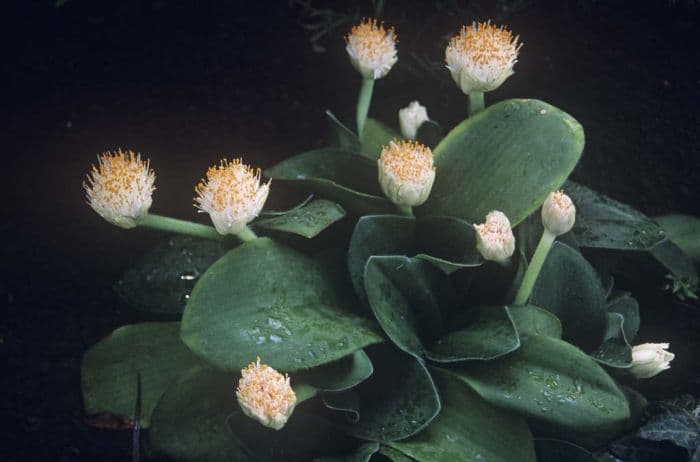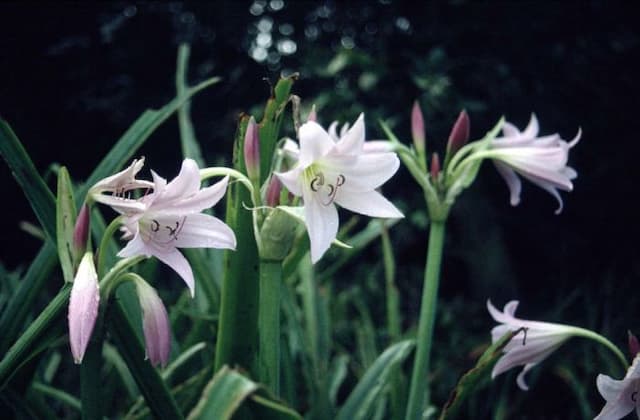Paintbrush Lily Haemanthus albiflos











ABOUT
The plant commonly known as Paintbrush Lily is notable for its unique and attractive features. It has thick, evergreen leaves that are dark green and glossy with a leathery texture, forming a lush foliage at the base. These leaves often present themselves in a strikingly symmetrical fashion, standing out against the backdrop of a shaded garden or indoor setting. What captures the attention most, however, are the distinctive flowers. Bloom clusters emerge atop sturdy stems, resembling paintbrushes dipped in white paint, hence the common name. Each flower cluster is composed of numerous small, star-shaped white blossoms. These are surrounded by conspicuous, long stamens that usually carry a butter-yellow hue, providing a striking contrast. Encircling the flower clusters at the base are several pale green bracts, which might be mistaken for petals at first glance. The bracts and flowers together create a spherical to slightly elongated cluster that forms a charming focal point in the plant's appearance. After the blooming period, the plant produces fleshy, orange-red berries that add further interest to its appearance. These berries replace the floral show with a dash of warm color amidst the green leaves. Overall, the Paintbrush Lily is a captivating plant that combines lush foliage with an extraordinary floral display, creating an eye-catching aesthetic in any suitable environment.
About this plant
 Names
NamesFamily
Amaryllidaceae.
Synonyms
Paintbrush, White Paint Brush, Powderpuff.
Common names
Haemanthus albiflos.
 Toxicity
ToxicityTo humans
The plant known as the Paintbrush is not commonly associated with toxicity to humans. There is no widespread documentation indicating it is poisonous. Therefore, if ingested, it is not typically expected to cause any severe symptoms of poisoning in humans. However, individuals may have varying sensitivities, and it is generally advisable to avoid eating any part of ornamental plants like the Paintbrush.
To pets
The Paintbrush is not specifically listed as toxic to pets by major animal safety organizations. It is not well-documented to cause severe symptoms of poisoning if pets ingest it. However, it's always prudent to prevent pets from eating plants, as individual animals might have sensitivities or allergies, and some plants may cause gastrointestinal upset, such as vomiting or diarrhea, regardless of their toxicity profile.
 Characteristics
CharacteristicsLife cycle
Perennials
Foliage type
Evergreen
Color of leaves
Green
Flower color
White
Height
1 foot (0.3 meters)
Spread
1 foot (0.3 meters)
Plant type
Bulb
Hardiness zones
9
Native area
South Africa
Benefits
 General Benefits
General Benefits- Low Maintenance: Haemanthus albiflos, commonly known as the Paint Brush plant, is known for being easy to care for, making it ideal for novice gardeners or those with a busy lifestyle.
- Decorative Appeal: With its unique brush-like flower heads and glossy green leaves, the Paint Brush plant adds an aesthetic touch to any indoor space.
- Drought Tolerance: This plant has an ability to withstand periods without water, reducing the need for frequent watering and care.
- Long Blooming Period: The Paint Brush plant often has a lengthy flowering season, providing a long-lasting display of its distinctive blooms.
- Non-Toxic: It is not known to be toxic, making it a safe choice for households with pets or children.
 Medical Properties
Medical PropertiesThis plant is not used for medical purposes.
 Air-purifying Qualities
Air-purifying QualitiesThis plant is not specifically known for air purifying qualities.
 Other Uses
Other Uses- Haemanthus albiflos, commonly known as 'paintbrush plant', can be utilized in horticultural therapy programs where its unique flowering process and tactile leaves provide sensory stimulation to participants.
- In landscaping, the plant is used for its low-maintenance qualities and resistance to drought, making it an ideal choice for xeriscaping in arid climates.
- The 'paintbrush plant' might be applied in educational settings, such as schools or botanical gardens, as a practical example for biology classes studying bulbous plant species and their growth cycles.
- Its aesthetic appeal allows for its use in floral arrangements and bouquets, especially when the flowers are in bloom, adding a touch of exoticism.
- The ability of Haemanthus albiflos to thrive in shady areas makes it an appropriate choice for adding greenery to dimly lit indoor spaces like office lobbies or hotels.
- Due to its sturdy nature, the plant is sometimes used in container gardens, where it can live for many years with minimal care.
- Enthusiasts of feng shui may employ Haemanthus albiflos as a component to balance energies in a home, believing its round leaves to symbolize metallic elements.
- The paintbrush plant can become a component in exotic pet habitats, providing a non-toxic plant option for decorating terrariums or vivariums.
- Its striking appearance and slow growth habit make Haemanthus albiflos ideal for use as a living sculpture or focal point in minimalist garden designs.
- Culinary experimenters sometimes use the large leaves of the paintbrush plant as natural platters or decoration for presenting appetizers and desserts, although the plant itself is not edible.
Interesting Facts
 Feng Shui
Feng ShuiThe Paintbrush plant is not used in Feng Shui practice.
 Zodiac Sign Compitability
Zodiac Sign CompitabilityThe Paintbrush plant is not used in astrology practice.
 Plant Symbolism
Plant Symbolism- Rarity and Uniqueness: Haemanthus albiflos, commonly known as the Paint brush plant, is not a common household plant, which makes it a symbol of rare beauty and uniqueness.
- Resilience and Adaptability: As a plant that can tolerate periods of neglect, the Paint brush plant represents the ability to adapt and thrive in less-than-ideal circumstances.
- Protection and Safety: With its bulbous base, the Paint brush plant is often associated with a sense of grounding and protection, representing safety and shelter.
- Cleansing and Purification: Its white flowers can symbolize purity and the clearing of negative energy, much like white sage is used in cleansing rituals.
- Rare Beauty: The unique appearance of its brush-like flowers can represent an appreciation for exotic and uncommon beauty.
- Renewal and Growth: As the plant can go dormant and re-emerge, it signifies renewal, rebirth, and the continuous cycle of growth.
 Water
WaterThe Paintbrush plant, commonly known as Haemanthus albiflos, requires watering that mimics its natural environment, which is typically dry with occasional rain. During its growing season in spring and summer, water the plant thoroughly once the top 1 to 2 inches of soil feel dry, about once a week, providing about 8 to 16 onzes depending on pot size and soil dryness. During the dormant period in fall and winter, reduce watering frequency to every two to three weeks, using 6 to 12 onzes of water each time. Always allow excess water to drain away to prevent root rot, and never let the plant sit in standing water.
 Light
LightThe Paintbrush plant prefers bright, indirect light to flourish. A spot near an east or north-facing window is ideal, as it allows the plant to receive ample light without the harsh direct sun that can scorch its leaves. If only a south or west-facing window is available, ensure that the plant is shielded from the direct sun with a sheer curtain or by placing it slightly away from the window.
 Temperature
TemperaturePaintbrush plants enjoy temperatures ranging between 60 to 75 degrees Fahrenheit. They can tolerate a minimum temperature of 50 degrees Fahrenheit but should not be exposed to temperatures below this, as they may suffer from cold damage. Avoid placing your Paintbrush plant in areas with drafts or sudden temperature changes to ensure its health and growth.
 Pruning
PruningPruning the Paintbrush plant is generally done to remove spent flowers and dead or damaged foliage to encourage healthy growth and improve its appearance. The best time to prune is after the plant has finished flowering. Pruning is not required frequently; inspect your plant during watering and prune as needed.
 Cleaning
CleaningAs needed
 Soil
SoilThe Paintbrush plant prefers well-draining soil mixed with sand and peat to ensure proper drainage and aeration. An ideal soil pH for Haemanthus albiflos is between 6.0 and 7.5. A mixture containing one part garden soil, one part peat or humus, and two parts sharp sand or perlite is recommended for optimal growth.
 Repotting
RepottingThe Paintbrush plant should be repotted every few years to refresh the soil and accommodate root growth. Repotting Haemanthus albiflos is typically necessary every 2 to 3 years, best done in the spring or early summer at the onset of the growing season.
 Humidity & Misting
Humidity & MistingPaintbrush plants enjoy moderate to high humidity levels, ideally between 40% and 60%. If the indoor environment is too dry, it can benefit from occasional misting or placing the pot on a tray with wet pebbles to increase the surrounding humidity.
 Suitable locations
Suitable locationsIndoor
Keep Paintbrush in bright, indirect light, water moderately.
Outdoor
Place Paintbrush in partial shade, sheltered from extreme weather.
Hardiness zone
9-11 USDA
 Life cycle
Life cycleHaemanthus albiflos, commonly known as the Paintbrush Plant, starts its life cycle as a seed that germinates in warm, moist soil, typically during spring. After germination, a bulb forms underground and a shoot emerges, developing into strap-shaped, evergreen leaves. As the plant matures, it produces a stout flowering stalk bearing a dense cluster of white flowers, often during autumn or winter. Following pollination, which can occur through insect activity, the flowers may develop into fleshy berries containing seeds. The berries eventually open, dropping seeds to the ground to enable new plants to grow, thus continuing the cycle. Throughout the year, the Paintbrush Plant's bulb remains in a state of rest or slow growth when not in active vegetative or reproductive phases.
 Propogation
PropogationPropogation time
Spring to Summer
The most common method for propagating Haemanthus albiflos, commonly known as the Paintbrush plant, is through division of the offsets, which are small bulblets that form around the base of the mother plant. The ideal time to propagate by division is in late summer or early fall, just before or during the onset of the plant's resting period. When the offsets have formed a decent size, they can be gently separated from the main plant using a clean, sharp knife. These offsets should then be allowed to dry for a day or two to callus over to prevent rotting. Afterward, they can be potted in a well-draining soil mix, placed at the same depth they were growing before, and watered sparingly until they establish their own roots and start to show growth, making sure to provide bright, indirect light during this period.









